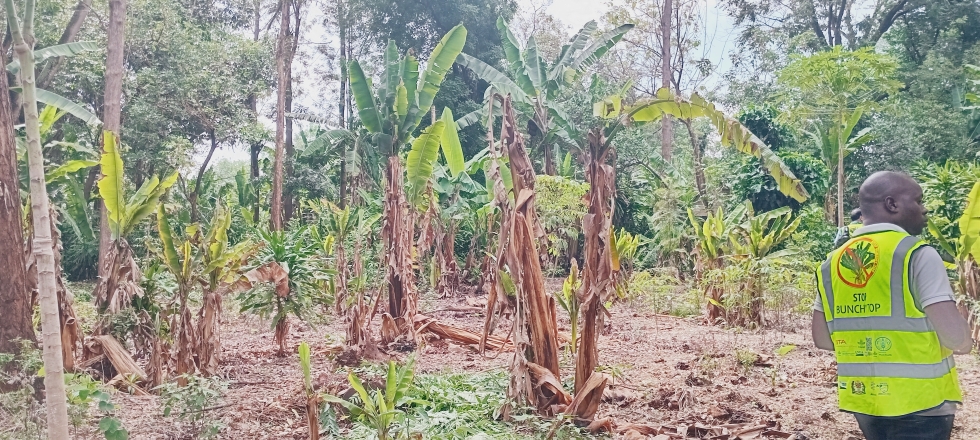Banana Plantations in Tanzania under serious threat as deadly disease wreaks havoc across seven regions
Banana plantations in Tanzania and one of the country’s popular staples are under serious threat due to the ongoing rapid spread of a deadly disease which has been defying interventions for nearly 150 years elsewhere in the world.
The Banana Bunch Top Disease (BBTD) the oldest and deadliest viral infection affecting mostly plantains is rapidly spreading across Tanzania destroying farms in more than seven regions of the mainland.
Farmers going bananas?
But the worst part of the bargain, according to agricultural experts, is that the viral disease has no cure with the only solution being uprooting and destroying all the affected plantains on the farms.
Speaking in Moshi, the Plant Pathologist from the International Institute of Tropical Agriculture, George Mahuku, said the IITA, is working to raise awareness among farmers across the country through farmer learning events teaching them on the proper measures, including cultural methods to reduce the spread.
“We don’t have any resistance to the disease and the only way is to resort to ‘prevention being better than cure,’” explained Mahuku, adding that, like other virus maladies, the Banana Top Disease has neither preventive remedy like herbicide nor pesticides.
Already experienced in Egypt, Burundi and DR Congo, the 145 years old Banana bunchy top disease (BBTD), is severely impacting banana production in Tanzania, threatening the country’s agricultural sector and food security as well as threatening livelihoods of millions of smallholder farmers.
The IITA pathologist explained that the banana top disease is only spread through transplanting of plantains from the affected regions to other parts and also transmitted by some small sap-sucking insects called aphids.

As it happens, the Banana bunchy top disease affects the banana fruit and foliage, and as described, is caused by a single-strand DNA infection, the Banana Bunchy Top Virus (BBTV).
The Banana bunchy top virus, on the other hand, is a plant pathogenic virus of the family Nanoviridae known for infecting banana plants and other crops and usually aphid transmitted.
“The only solution is to destroy all affected plantains, clear the farms and wait for three months then introduce fresh crops that have been approved by agricultural experts and recognized institutions,” said Mahuku.
During a visit to some affected farms in Moshi, in Kilimanjaro, an expert researcher from the Tanzania Plant Health and Pesticides Authority (TPHPA) Hamadi Lyimo, explained that the disease was first traced in Buhigwe District of Kigoma Region, in 2020.
The disease had apparently crossed into Tanzania from Burundi where it affected farms after spreading from the Democratic Republic of Congo where it was first traced in the 1960s.
From the shores of Lake Tanganyika along the western peninsular, the BBTD made headway inland.
In 2021 the Banana Bunchy Top disease spread to Northern Tanzania, affecting bananas in the Moshi urban and rural districts of Kilimanjaro, then afterwards blew out to other mainland regions of the country.
Seven regions including Dar-es-Salaam, Pwani, Morogoro, Mbeya, Kilimanjaro, Kigoma, Mwanza and even some selected places like Dodoma where banana plantations are few and far apart.
The Agricultural Officer for Ng’ambo and Msalanga wards of Moshi District, Sufiani Ally Mganga said before the disease erupted in Kilimanjaro, farms in each of the two local wards used to produce over 6 tons of bananas per year, but the production is less than half-a-ton.
“That also explains why the prices of bananas have been shooting up, much to the amazement and disappointment of consumers,” pointed out Mganga, warning that the pandemic may cause acute food shortages in future.
The Agricultural officer said the biggest challenge at the moment is to convince farmers to uproot the plantains, as they depend on them for food and income, but the more they delay the worse the situation gets and chances are the entire crop will be annihilated from Kilimanjaro.
One of the local farmers Allen William from Ng’ambo whose entire plantation dried up due to the disease said he has convinced his neighbors to also uproot theirs to prevent infections.
The disease was first observed in the Southern Pacific, precisely Fiji in 1879, in Egypt around 1900 and later spread onto Sri Lanka and Australia in 1913.
In East Africa the disease started in the Democratic Republic of Congo in the 1960s before spreading to Burundi, from where it then crossed Lake Tanganyika into Kigoma in 2020.

